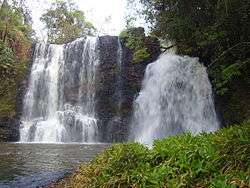Torrinha
| Torrinha | |
|---|---|
| Municipality | |
 | |
 Location in São Paulo state | |
 Torrinha Location in Brazil | |
| Coordinates: 22°25′34″S 48°10′9″W / 22.42611°S 48.16917°WCoordinates: 22°25′34″S 48°10′9″W / 22.42611°S 48.16917°W | |
| Country |
|
| Region | Southeast Region |
| State | São Paulo |
| Area | |
| • Total | 315 km2 (122 sq mi) |
| Population (2015) | |
| • Total | 9,846 |
| • Density | 31/km2 (81/sq mi) |
| Time zone | BRT/BRST (UTC-3/-2) |
Torrinha is a municipality in the state of São Paulo in Brazil. The population is 9,846 (2015 est.) in an area of 315 km².[1] The elevation is 802 m.
History
The occupation and settlements where today the municipality of Torrinha is located have been shaped by colonization towards the center of the country in the search for wealth. In the 17th and 18th centuries this portion of the Sao Paulo area was cut by paths of tropeiros and travellers who landed. With the need for supplies of food, supplies and services and repairs, emerged fledgling business and service delivery; enabling the establishment of the first settlers of the region and the formation of populated areas.
This process of occupation intensified with the donation of Sesmarias which gave way and outlined the major farms, embryos of future urban areas. The Land Law of 1850 benefited from the arrival of people from other regions of the country that had established themselves with subsistence farming in areas near the small village.
Through documents and records, it is known that some families have lived in Torrinha since 1850. Some of these pioneering family names include: Fonseca Costa, Mello, Dias, Ferreira, Ferraz, Gomes, Ribeiro del Prado, Dias Ramos, Carvalho, Franco de Moraes, Souza, Barros, Teixeira, Milk, Marques, Paiva, France, Pinto, Melchert, Barbosa and Bueno.
Historically, Jose Antunes de Oliveira is considered the founder of Torrinha, they've donated to the Bishopric of Sao Paulo a small area where a chapel was built in honor of San Jose, considered the patron saint of the city. It is estimated that this was around 1870, i.e., nineteen years before the Republic.
In 1880, documents record the arrival of Jerome Martins Coelho, grandson of Lord of Cocais, coming from the edge of Mata, Minas Gerais; they acquired large amounts of land that reached the localities of Santa Maria da Serra, Torrinha, Brotas Two and streams. It was installed for a long time on land where today is the Power Plant of the Three Jumps and built on this ranch is one of the first Presbyterian churches of the state.
During this period the population grew and with the arrival of Pope Benedict Lacerda, who was the son of the Baron de Araras, Benedict Lacerda Guimaraes and Mrs. Manuel Franco, in 1886, the little village became more prominent. Benedict Lacerda had just returned home, from Germany, where he had studied at the Polytechnic University of Hannover, specializing in chemistry and mining. He accepted the challenge and came to work on the land purchased by Baron. The creation of the District Police in 1892 and District of Peace in 1896 is attributed to him.
The economic development of this region increased around the 19th century with the introduction of sugar production. The cultivation of sugar cane in the city of Torrinha due to its proximity of the areas of sugar farming Piracicaba, Araraquara and San Carlos. Meanwhile, local conditions did not favor the permanence of that culture. The cycle of sugar cane spurred the settlement and colonization, favoring the introduction of coffee growing and encouraging the arrival of immigrants.
The coffee culture has been introduced in the city at the end of the 19th century and its development is associated with the construction of the railroad company Paulista de Estradas de Ferro, inaugurated on September 7, 1886 under the name of railway station of Santa Maria and later Torrinha.
The station represented the largest force in the development of the city that needed a means of shipping of its main agricultural product, coffee, but also has allowed for the transport of passengers.
Geography
Large mountainous areas consisting of basaltic and sandstone mountains as tall as 80 km lie within the perimeter of Torrinha, along with 34 other canyons. The potential for tourist attractions associated with this geological feature is indisputable with walls up to 100 feet tall, beautiful waterfalls, caves of sandstone and basalt, and even a gallery forest and well-preserved primary hillsides can be found in narrow valleys still unexplored.
Torrinha is part of the western Sao Paulo plateau, which includes the geotectonic unit called Paraná Basin, where accumulation of thick sedimentary masses and basaltic volcanic eruptions occurred in the Tertiary period (Cenozoic Age – between 70 and 12 million years), caused underground tectonic and erosive processes; hence the emerging festooned-scarp relief called "cuestas" (Spanish: Encuestas) arranged in arcs towards the Brazilian Highlands, which encompasses the "Torrinha" rock as well.
The municipality also has about 5% of its original native vegetation preserved. Of this total, almost 100% is composed of vegetation on slopes. Savannah and broad-leaved tropical forest species still exist in small isolated areas, although they have been almost completely decimated for being originally considered proper for agriculture and stock breeding. Fortunately, the presence of numerous rock walls and slopes that sprang from the "cuestas", primarily an "embarrassment" for the settlers from the beginning of the 20th century, preserved this natural and important sanctuary treasure for biodiversity in the state of Sao Paulo.
